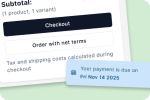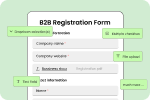In today’s digital-first business landscape, companies are constantly seeking ways to streamline operations, improve partner relationships, and accelerate growth. Enter the B2B portal – a powerful place that’s transforming how businesses interact, transact, and collaborate with their suppliers, partners, and customers.
A B2B portal is a centralized online place designed specifically to facilitate seamless interactions, transactions, and communication between businesses. This B2B self-service capability, combined with robust management features, makes B2B customer portals essential infrastructure for modern commerce.
Whether you’re considering implementing a B2B portal or looking to optimize your existing website, this article will provide the insights you need to make informed decisions.
What is a B2B Portal?
A B2B portal is a centralized digital B2B place that enables businesses to transact, communicate, and manage relationships with their suppliers, partners, distributors, and customers.
While a traditional B2B website is essentially a digital brochure – providing information but requiring offline processes for transactions – a portal is a fully operational business solution. Users can log in to access personalized pricing based on their negotiated contracts, view their purchase history, reorder frequently purchased items with a single click, track shipments in real-time, and even collaborate with account managers through built-in messaging systems.

A B2B portal typically includes product and service listings with detailed specifications, real-time inventory tracking systems, streamlined ordering processes, account management dashboards, secure payment processing, and integrated communication tools. These capabilities work together to create an efficient, transparent, and user-friendly environment for conducting business operations.
B2B customer portals also provide significant backend capabilities for the businesses operating them. Administrators can segment customers into different tiers, apply custom pricing rules, manage user permissions across organizational hierarchies, generate detailed analytics reports, and automate routine processes like order confirmations and invoice generation. This level of control and automation is impossible to achieve with a standard website.
The result is a B2B platform that doesn’t just present information but actively facilitates business operations, reduces manual workload, minimizes errors, and creates a superior experience for all parties involved. For businesses looking to scale efficiently in competitive markets, a well-designed B2B portal isn’t just a nice-to-have – it’s becoming an essential competitive advantage.
>> Read more: B2B vs B2C Ecommerce: Key Differences and Trends
Key Features of B2B Portals that Drive Growth
The true power of a B2B portal lies in its feature set. These capabilities work together to streamline operations, enhance customer experience, and ultimately drive business growth. Let’s explore the essential features that make B2B customer portals so effective.
Product Catalog Management
A robust product catalog is the foundation of any successful B2B portal. Unlike simple product listings on a standard website, B2B portal catalogs are dynamic and intelligent. They support advanced segmentation capabilities that allow different customer groups to see different product selections, pricing, and availability based on their relationship with your business.
Personalized pricing is particularly crucial in B2B transactions, where negotiated rates, volume discounts, and contract-based pricing are the norm rather than the exception. A sophisticated B2B customer portal can automatically display the correct prices to each logged-in customer, eliminating confusion and reducing the need for manual quote generation. Some portals even support tiered pricing structures that automatically adjust based on order quantities, encouraging larger purchases.
Advanced catalog features might also include product recommendations based on purchase history, the ability to save custom product lists for easy reordering, and integration with product information management (PIM) systems to ensure data accuracy across all channels.
For Shopify merchants, B2Bridge makes sophisticated product catalog management effortless by automatically displaying customer-specific pricing and product visibility based on login credentials – no coding required.
Order and Inventory Management
Real-time order tracking transforms the customer experience by providing complete visibility into the order lifecycle. From the moment an order is placed until it arrives at the destination, customers can monitor its progress without needing to contact customer service. This transparency builds trust and reduces the administrative burden on your team.
Automated fulfillment workflows further enhance efficiency by routing orders to the appropriate warehouse or supplier, triggering picking and packing processes, and generating shipping labels – all without manual intervention. When integrated with inventory management systems, B2B portals can provide accurate stock monitoring, automatically update availability across all channels, prevent overselling, and even trigger reorder alerts when inventory reaches predetermined thresholds.
For businesses managing multiple warehouses or dropshipping arrangements, advanced portals can implement intelligent routing logic that selects the optimal fulfillment location based on customer proximity, stock levels, and shipping costs.
Payment Processing and Billing Integration
Secure, flexible payment processing is non-negotiable in modern B2B Ecommerce. B2B portals typically support multiple payment methods including credit cards, ACH transfers, purchase orders, and net payment terms – often all within the same transaction flow. This flexibility accommodates different customer preferences and business requirements.
The integration of invoicing systems streamlines the accounting process by automatically generating invoices upon order completion, applying the correct tax rates based on customer location, and syncing with accounting software like QuickBooks or NetSuite. Some advanced portals even support automated payment reminders, partial payment tracking, and integrated credit limit management to minimize payment delays and bad debt risk.

Customer Account and User Role Management
Enterprise B2B relationships often involve multiple stakeholders with different responsibilities and authorization levels. A sophisticated B2B customer portal implements hierarchical access controls that allow you to create organizational structures within customer accounts. For example, a purchasing manager might have approval authority up to a certain dollar amount, while a procurement director has unlimited authority, and individual employees can browse and add items to carts but cannot complete purchases.
These purchase authorization workflows ensure compliance with internal procurement policies while maintaining efficiency. This B2B self-service can route orders through approval chains automatically, notify approvers via email, and provide audit trails for all transactions – features that are essential for enterprises but would be impossible to manage with traditional Ecommerce platforms.
Communication and Collaboration Tools
Effective communication is the backbone of strong business relationships. Modern B2B portals integrate various communication tools to facilitate seamless interactions. Discussion forums allow community members to share insights and solve problems collaboratively. Live chat features enable real-time support for technical questions or order issues. Integrated messaging systems let buyers communicate directly with their account representatives without leaving the portal environment.
Automated notifications keep all parties informed about important events like order confirmations, shipping updates, inventory alerts, and special promotions. These proactive communications reduce uncertainty and the need for status inquiry calls, freeing up your team to focus on more strategic activities.
Analytics and Reporting
Data-driven decision-making is critical for growth, and B2B customer portals provide the analytics infrastructure to support it. Comprehensive dashboards offer insights into sales trends, customer behavior patterns, product performance, and inventory forecasting. Businesses can identify their top-performing products, recognize seasonal buying patterns, understand which customers are growing or declining, and spot opportunities for upselling or cross-selling.
Advanced portals might include cohort analysis to understand customer lifetime value, abandoned cart reporting to identify friction points in the purchase process, and predictive analytics that forecast future demand based on historical patterns. These insights enable more strategic inventory planning, targeted marketing efforts, and proactive customer relationship management.
Intelligent Automation
Artificial intelligence and machine learning are increasingly being integrated into B2B portals to enhance both the user experience and operational efficiency. AI-driven product recommendations can suggest complementary items or alternatives based on purchase history and browsing behavior, increasing average order values. Intelligent chatbots provide instant answers to common questions, qualify leads, and even assist with order placement outside of business hours.
Demand prediction features use historical data and market signals to forecast future purchasing patterns, enabling more accurate inventory planning and proactive outreach to customers likely to reorder soon. These automation capabilities not only improve the customer experience but also significantly reduce the manual workload on your team, allowing you to scale operations without proportionally increasing headcount.
Ready to implement these powerful B2B features on your Shopify store? Book a free consultation with B2Bridge to discover how you can transform your wholesale operations and unlock new growth opportunities.

Types of B2B Portals and Industry Examples
B2B portals come in various forms, each designed to serve specific business models and industry needs. Understanding these different types can help you identify the best approach for your organization.
Service Portals
Service portals cater to businesses offering professional services rather than physical products. These platforms typically feature service catalogs that detail offerings, pricing structures, and delivery timelines. Request for Proposal (RFP) tools allow clients to submit project requirements and receive detailed proposals. Project management integrations enable clients to track service delivery progress, review milestones, and communicate with service teams.
Example: Upwork operates a comprehensive freelance marketplace portal that connects businesses with independent professionals. Clients can browse talent profiles, post project requirements, review proposals, manage contracts, track work hours, and process payments – all within a single platform. This centralized approach has made Upwork the go-to platform for businesses seeking flexible talent solutions.
Supplier Portals
Supplier portals centralize all communications and transactions between buying organizations and their supplier networks. These portals streamline procurement processes by providing suppliers with purchase order visibility, delivery schedule information, quality requirements, and payment status updates. Buyers benefit from standardized supplier onboarding, performance metrics tracking, and consolidated ordering across multiple suppliers.
For businesses operating on Shopify, creating a supplier portal has become increasingly accessible through specialized B2B apps. Shopify’s flexible platform, combined with B2B-focused applications, enables merchants to transform their stores into comprehensive supplier portals without custom development costs.
Example: Trailer Valet demonstrates this approach effectively. The company manufactures innovative trailer moving solutions and is needed to serve both retail consumers and wholesale dealers through a single platform. By implementing B2Bridge on their Shopify store, Trailer Valet created a sophisticated dealer portal that offers authorized distributors access to wholesale pricing, bulk ordering capabilities, and streamlined reordering processes.
The portal allows their dealer network to place orders 24/7, view their complete order history, and access dealer-specific pricing – all while Trailer Valet maintains a unified inventory system across both retail and wholesale channels. This solution eliminated the operational complexity of managing separate platforms while providing dealers with the professional B2B experience they expect from a supplier partner.

Community Portals
Community portals foster networking, knowledge sharing, and collaboration within specific industries or professional groups. These platforms typically feature discussion forums, resource libraries, event calendars, member directories, and news feeds. While not always transactional in nature, community portals create value by building relationships that often lead to business opportunities.
Example: LinkedIn Groups function as community portals for professional networking and knowledge exchange. Industry-specific groups allow professionals to share insights, ask questions, discuss trends, and identify potential business partners or customers. While LinkedIn itself isn’t primarily a transaction platform, the relationships formed through these community features frequently result in B2B deals.
Partner Portals
Partner portals support distributor, reseller, and channel partner ecosystems. These platforms provide partners with access to product information, marketing materials, training resources, deal registration systems, and co-marketing fund management. Integration with CRM and ERP systems ensures that partners can access inventory availability, place orders on behalf of customers, and track commissions or rebates.
Example: The Amazon Partner Network portal supports the vast ecosystem of Amazon Web Services resellers and consulting partners. The portal provides certification programs, technical documentation, customer lead sharing, co-selling opportunities, and commission tracking. This comprehensive support system has enabled Amazon to scale its cloud services globally through a network of specialized partners.
E-learning Portals
E-learning portals host corporate training programs, certification courses, and educational content for business customers. These platforms feature course catalogs, learning management systems (LMS), progress tracking, assessment tools, and certificate generation. For businesses selling training or requiring customer education about complex products, e-learning portals are invaluable.
Example: Coursera for Business provides enterprises with access to thousands of professional development courses from top universities and companies. The portal includes admin dashboards for tracking employee progress, custom learning path creation, integration with HR systems, and ROI analytics. This platform has become essential for companies investing in continuous employee development.

Benefits of Implementing B2B Portals
The advantages of implementing a comprehensive B2B Ecommerce customer portal extend across all aspects of business operations:
- Streamlined communication and centralized operations reduce the time spent on routine inquiries, order status checks, and information gathering, allowing teams to focus on strategic initiatives that drive growth.
- Enhanced customer experience through personalization and self-service capabilities empowers buyers to conduct business on their own terms, 24/7, without waiting for sales representatives or customer service responses.
- Scalable solutions that support business expansion enable companies to serve more customers and process more transactions without proportionally increasing operational costs or headcount.
- Data-driven decision-making enabled by integrated analytics transforms raw transaction data into actionable insights about customer behavior, product performance, and market trends.
- Cost savings through process automation and reduced manual intervention eliminate redundant tasks, minimize errors, and improve operational efficiency across the organization.
- Improved order accuracy as customers input their own orders reduces transcription errors and ensures that orders reflect exactly what customers intended to purchase.
- Stronger customer relationships built on transparency, convenience, and responsiveness increase loyalty and lifetime value.
- Competitive differentiation as a sophisticated B2B portal signals professionalism and technological sophistication that can win deals against competitors with less developed digital capabilities.
Challenges and Best Practices in B2B Customer Portal Development
While the benefits are substantial, implementing a B2B portal comes with challenges that require careful planning:
Integration complexities with existing ERP, CRM, and PIM systems require thorough technical planning and often the expertise of specialized developers or platforms designed for B2B Ecommerce.
Security and compliance assurance across all data transactions demands robust authentication, encryption, and access control measures, especially when handling sensitive business and financial information.
Designing intuitive user interfaces that cater to diverse business roles and varying levels of technical expertise requires user research, iterative testing, and ongoing refinement based on feedback.
Planning for scalability and future feature enhancements ensures your portal can grow with your business without requiring complete rebuilds every few years.
Managing change management as your team and customers adapt to new processes requires training, documentation, and patient support during the transition period.
Balancing customization with maintainability involves making strategic decisions about which features to build custom versus which to leverage from platform capabilities.
Best practices include: Starting with core features and expanding gradually, choosing platforms with robust integration capabilities, prioritizing mobile responsiveness, implementing comprehensive testing before launch, gathering user feedback continuously, and maintaining clear documentation for both administrators and end-users.
How B2B Portal of B2Bridge Growth Your B2B Business on Shopify
B2Bridge offers robust B2B Shopify portals and sales portals tailored for Ecommerce businesses, providing a perfect solution to build a strong online presence while attracting new customers and partners. These portals empower merchants to effectively manage product catalogs, monitor order statuses, and handle transactions seamlessly – all within their existing Shopify stores – removing the need for a separate site.

Key features include:
- Custom Pricing and Price Lists: Assign personalized discounted prices, volume discounts, and specific product pricing to different customer groups, enabling precise control over wholesale pricing and customer segmentation.
- B2B Registration & Verification: Customized wholesale registration forms allow businesses to verify and approve legitimate B2B customers, ensuring secure and exclusive access to wholesale pricing and features.
- Order Management: The portal includes quick order forms enabling bulk ordering, manual orders for flexible sales processes, and support for Request for Quote (RFQ) workflows, facilitating efficient buyer-seller negotiations.
- Net Payment Terms: Offer flexible payment options like net 30, net 60, or net 90 terms to accommodate B2B buyers’ payment preferences, improving purchase convenience and cash flow management.
- Seamless Storefront Experience: B2Bridge replaces default Shopify product, cart, and checkout pages for logged-in B2B customers with custom interfaces. These display B2B-specific prices, volume discounts, purchase limits, and a streamlined ordering experience to boost conversion and buyer satisfaction.
- Integration & Automation: The app supports importing and exporting price lists and connects via APIs with ERP and CRM systems, automating wholesale data management and reducing manual work.
B2Bridge’s B2B portal is a comprehensive toolkit that transforms Shopify stores into powerful, dedicated wholesale channels. The app enables businesses to scale with confidence, protect pricing strategies by hiding wholesale prices from retail customers, and save time by automating key operations like registration, order handling, and pricing updates. Buyers enjoy a smooth, self-serve journey with personalized experiences, driving loyalty and repeat wholesale orders.
By consolidating everything in one unified store with dedicated B2B features, B2Bridge helps Shopify businesses close more wholesale deals efficiently and future-proofs their growth without the complexity of managing multiple apps or sites. This makes it an ideal portal solution for brands aiming to boost their B2B Ecommerce success on Shopify.
Ready to transform your B2B operations? Discover how B2Bridge can help you build a powerful B2B portal on Shopify and unlock new growth opportunities for your wholesale business.
FAQs About B2B Portals
A B2B portal is a centralized digital platform that enables businesses to transact, communicate, and manage relationships with their suppliers, partners, and customers through features like order management, personalized pricing, and account control.
B2B stands for “Business-to-Business” referring to commercial transactions and relationships between companies rather than between businesses and individual consumers.
A B2B portal offers interactive transaction and management capabilities like personalized pricing, order placement, account management, and real-time inventory visibility, while a typical website primarily provides information. Portals enable self-service business operations; websites require offline follow-up for transactions.
B2B portals focus on bulk ordering, custom pricing, credit terms, and approval workflows for business buyers, while B2C portals prioritize individual consumer purchases with standard pricing and simplified checkout processes.
A B2B business website is an informational site that showcases products or services to business customers but typically lacks the interactive transaction and account management features found in full B2B portals.
A B2B platform works by providing authenticated business users with personalized access to catalogs, pricing, and ordering tools while automating backend processes like inventory management, payment processing, and order fulfillment.
Absolutely. Modern B2B portal solutions, including apps like B2Bridge – All-in-One B2B Ecommerce Solution for Shopify, make enterprise-level portal capabilities accessible to businesses of all sizes. SMEs can start with essential features and scale as they grow, often at a fraction of the cost of custom development.
Custom B2B portal development can take 6-18 months and cost $50,000-$500,000+ depending on complexity. However, platform-based solutions like Shopify with B2B apps can be implemented in weeks to months at significantly lower costs, making them ideal for most businesses (example using B2Bridge starts at $99 → View pricing plan).
Conclusion
B2B portals have evolved from nice-to-have digital amenities to essential infrastructure for businesses serious about growth in competitive markets. By centralizing operations, automating routine processes, and providing superior customer experiences, these platforms enable businesses to scale efficiently while maintaining strong relationships with partners, suppliers, and customers.
Hi, I’m Ha My Phan – an ever-curious digital marketer crafting growth strategies for Shopify apps since 2018. I blend language, logic, and user insight to make things convert. Strategy is my second nature. Learning is my habit. And building things that actually work for people? That’s my favorite kind of win.






